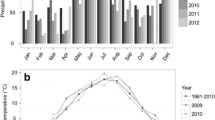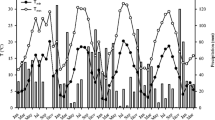Abstract
Broomcorn is a sub-species of sorghum principally cultivated for its inflorescences, which take the form of panicles from which brooms are manufactured. Broomcorn cultivation is common on small properties, occupying marginal areas or grown in rotation with traditional crops. Despite the generalized use of plastics, there is a wide and increasing market for hand-made products fabricated from natural materials, which can represent a good opportunity for additional revenue to low-income families. There have been few studies on broomcorn, and, in particular, there are no reported scientific studies of the performance of this species of sorghum in agroforestry systems. In the present study, production into various organs of broomcorn (stem, leaves, panicle, and seeds) has been evaluated as a function of the availability of solar radiation, in order to assess the adaptive capacity of broomcorn. In a field study, broomcorn plants were submitted to solar radiation moderated by shading provided by adjacent trees, corresponding to different levels (IR) of full-sun irradiance, varying from 42 to 95%. The evaluated plant biomasses displayed close relationships with the available radiation. Out to distances slightly greater than their height, the shading trees had a negative influence on plant biomass production. Once the quantity of received radiation exceeded about 83% of that provided by full sun, the sorghum production displayed only small changes with further increases in available radiation. It did appear that a small reduction in the available radiation was beneficial, for production at IR = 88–92% was observed to be between 2 and 22% greater than under IR = 95%, depending on the production parameter considered. In response to a decrease in the irradiance, broomcorn showed an increased capacity to exploit solar radiation. Consideration of the current methods of agricultural production of broomcorn and the poverty of the small properties on which it is raised indicates that there are excellent prospects for success from the future cultivation of broomcorn within agroforestry systems. Additional beneficial factors are crop protection by the trees and conservation of forested areas. An agroforestry system will offer increased production from the broomcorn crop together with new products coming from the trees, and the start of small agriculture-based industries.



Similar content being viewed by others
Notes
Field observations, unpublished data.
References
Baggio AJ, Caramori PH, Androcioli Filho A, Montoya L (1997) Productivity of southern Brazilian coffee plantations shaded by different stocking of Grevillea robusta. Agroforestry Systems 37(2):111–120
Baker DN, Meyer RE (1966) Influence of stand geometry on light interception and net photosynthesis in cotton. Crop Sci 6:15–19
Berenji J, Dahlberg J (2004) Perspectives of sorghum in Europe. J Agron Crop Sci 190:332–338
Berenji J, Dahlberg J, Sikora V, Latković D (2011) Origin, history, morphology, production, improvement, and utilization of broomcorn [Sorghum bicolor (L.) Moench] in Serbia. Econ Bot 65(2):190–208
Bernardes MS, Furia LRR, Teramoto ER, Bernardo KT (1998a) Interações abaixo da superfície do solo em sistema agroflorestal de seringueira (Hevea brasiliensis) e milho (Zea mays). In: Congresso Brasileiro em Sistemas Agroflorestais, 2. Resumos expandidos, Embrapa CPATU, Belém, pp 14–16
Bernardes MS, Goudriaan J, Câmara GMS, Dourado-Neto D (1998b) Tree-crop interactions in agroforestry system of rubber with soybean and maize. In: Congress of the European Society for Agronomy, vol 5, pp 125–126
Cannel MGR (1976) Crop physiological aspects of coffee bean yield. Kenya Coffee 41(484):245–253
Chang J (1968) Climate and agriculture: an ecological survey. Aldine, Chicago, 304p
Dahlberg J, Berenji J, Sikora V, Latković D (2011) Assessing sorghum [Sorghum bicolor (L.) Moench] germplasm for new traits: food, fuels & unique uses. Maydica 56(1750):85–92
Doggett H (1988) Sorghum. Longman Scientific & Technical, London
Foltran DE (2012) O sorgo-vassoura como alternativa agrícola regional. Pesquisa & Tecnologia. http://www.aptaregional.sp.gov.br/acesse-os-artigos-pesquisa-e-tecnologia/edição-2012/janeiro-junho-2/1204-o-sorgo-vassoura-como-aletrnativa-agricola-regional/file.html?force_download=1. Accessed 23 Mar 2015
Goudriaan J (1977) Crop micrometeorology: a simulation study. PUDOC, Wageningen (Simulation Monographs)
Huxley PA (1985) The tree/crop interface—or simplifying the biological/environmental study of mixed cropping agroforestry systems. Agrofor Syst 3:251–266
Huxley PA (1999) Tropical agroforestry. Blackwell Science, Oxford
ICRISAT International Crops Research Institute for the Semi-Arid Tropics (2004) Sorghum a crop of substance. ICRISAT, Patancheru
Mann JA, Kimber CT, Miller FR (1983) The origin and early cultivation of sorghums in Africa. Tex Agric Exp Stn Bull 1454:1–21
Monteith JL, Ong CK, Corlett JE (1991) Microclimatic interactions in agroforestry systems. For Ecol Manag 45:31–44
Morais H, Marur CJ, Caramori PH, Ribeiro AMA, Gomes JC (2003) Características fisiológicas e de crescimento de cafeeiro sombreado com guandu e cultivado a pleno sol. Pesquisa Agropecuária Brasileira 38(10):1131–1137
Nair PKR (1989) Agroforestry systems in the tropics. Kluwer Academic, Dordrecht
Nair PKR, Kumar BM, Nair VD (2009) Agroforestry as a strategy for carbon sequestration. J Plant Nutr Soil Sci 172:10–23
Ong CK, Corlett JE, Singh RP, Black CR (1991) Above and below-ground interactions in agroforestry systems. For Ecol Manag 45:45–57
Ong CK, Corlett JE, Marshall FM, Black CR (1996) Principles of resource capture and utilization of light and water. In: Ong CK, Huxley P (eds) Tree-crop interactions: a physiological approach, vol 4. CAB International, Wallingford, pp 73–158
Pinto LFG (2002) Avaliação do cultivo da cana-de-açúcar em sistemas agroflorestais em Piracicaba, Doctor thesis E.S.A. “Luiz de Queiroz”, University of São Paulo, Piracicabam, p 116
Righi CA (2000) Interações ecofisiológicas acima e abaixo do solo em um sistema agroflorestal de seringueira (Hevea brasiliensis) e feijoeiro (Phaseolus vulgaris). M.Sc. thesis E.S.A. “Luiz de Queiroz”, University of São Paulo, Piracicaba. p 130
Righi CA (2005) Avaliação Ecofisiológica do Cafeeiro (Coffea spp) em Sistema Agroflorestal e em Monocultivo. Doctor thesis E.S.A. “Luiz de Queiroz”, University of de São Paulo, Piracicaba, p 101
Righi CA, Bernardes MS, Lunz AMP, Pereira CR, Dourado-Neto D, Favarin JL (2007) Measurement and simulation of solar radiation availability in relation to the growth of coffee plants in an agroforestry system with rubber trees. Rev Arvore 31:195–207
Righi CA, Couderc V, Pereira CR, Couto HTZ, Silva LD (2016) Effect of shade on biomass accumulation and partitioning for Eucalyptus camaldulensis sprouts. J Sustain For 35(1):75–87
Sawazaki E, Foltran DE, Camargo MS (2006) Efeitos do nitrogênio em cobertura e população de plantas na produção e qualidade da palha de duas variedades de sorgo-vassoura. In: Cong Nac Milho e Sorgo, 26. Anals…Embrapa, Belo Horizonte, p 326
Shibles RM, Weber CR (1965) Leaf area, solar radiation interception, and dry mater production by various soybean planting patterns. Crop Sci 6:55–59
van Raij B, Cantarella H, Quaggio JA, Furlani AMC (1996) Recomendações de adubação e calagem para o Estado de São Paulo, 2nd edn. Instituto Agronômico & Fundação IAC, Campinas (Technical Bulletin n. 100)
Viégas GP (1941) A seleção do sorgo-vassoura. Bragantia 1(2): 177–232
Wendorf F, Close AE, Schild R, Wasylikowa RK, Housley RA, Harlan RA, Krolik H (1992) Saharan exploitation of plants 8000 years BP. Nature 359:721–724
Williams WA, Loomis RS, Lepley CR (1965) Vegetative growth of corn as affected by population density. l. Productivity in relation to interception of solar radiation. Crop Sci 5:211–215
Willey RW, Reddy MS (1981) A field technic for separating above-and bellow interactions in intercropping and experiment with pearl millet groundnut. Experimental Agriculture 17:257–264
Acknowledgements
We are grateful for the support received from Prof. Dr. Hilton Thadeu Z. Couto for the help in the statistical analyses and Prof. Dr. Carlos Rodrigues Pereira for discussions on microclimate interaction and plants responses.
Author information
Authors and Affiliations
Corresponding author
Rights and permissions
About this article
Cite this article
Righi, C.A., Foltran, D.E. Broomcorn [Sorghum bicolor (L.) Moench] responses to shade: an agroforestry system interface simulation. Agroforest Syst 92, 693–704 (2018). https://doi.org/10.1007/s10457-016-0036-7
Received:
Accepted:
Published:
Issue Date:
DOI: https://doi.org/10.1007/s10457-016-0036-7




